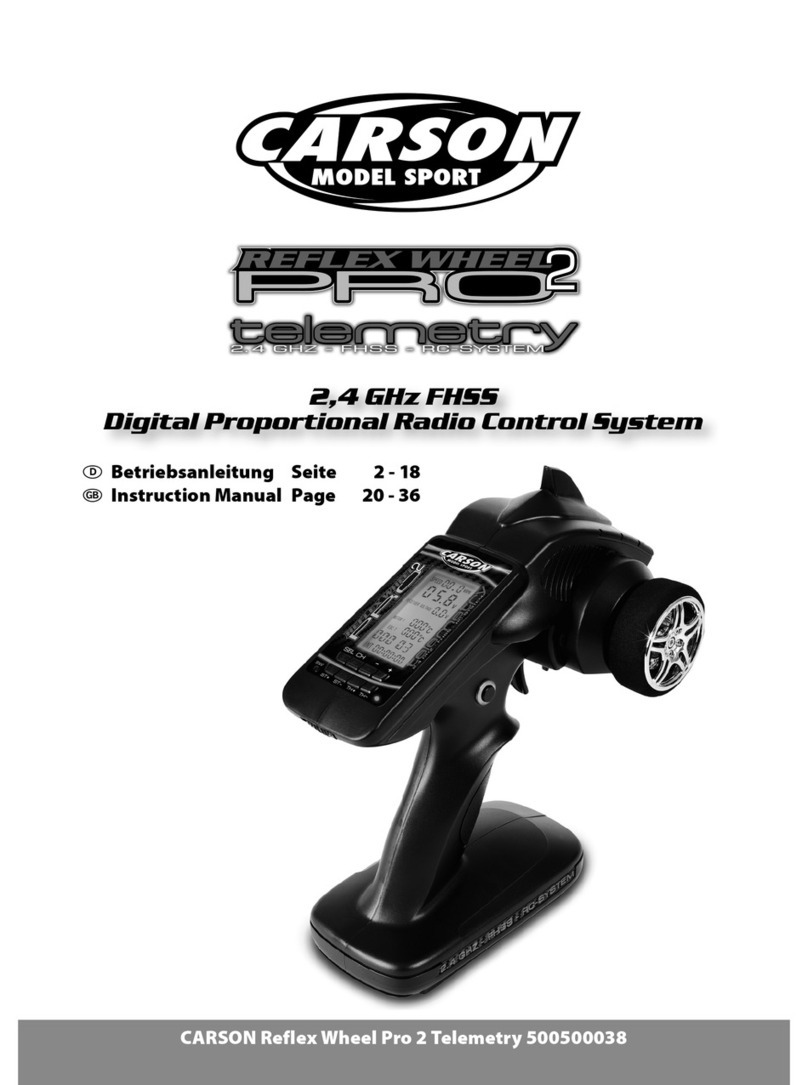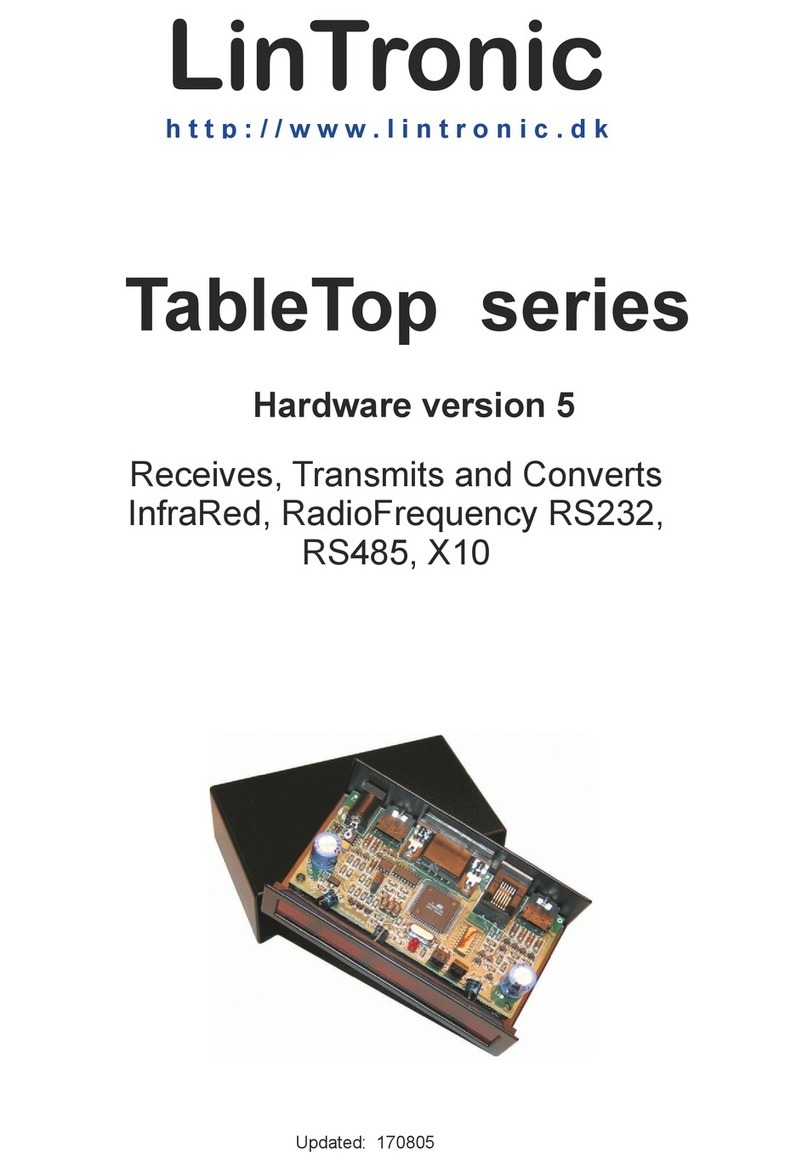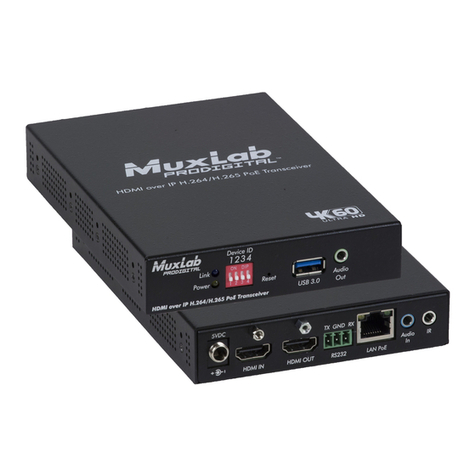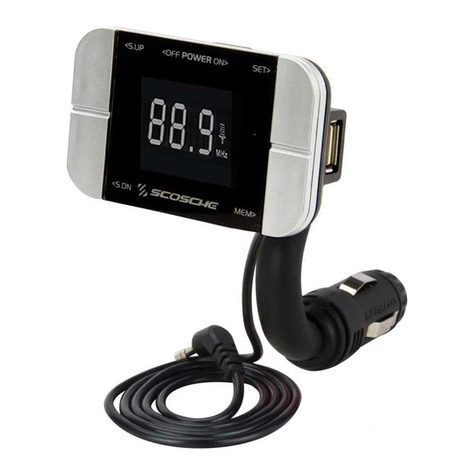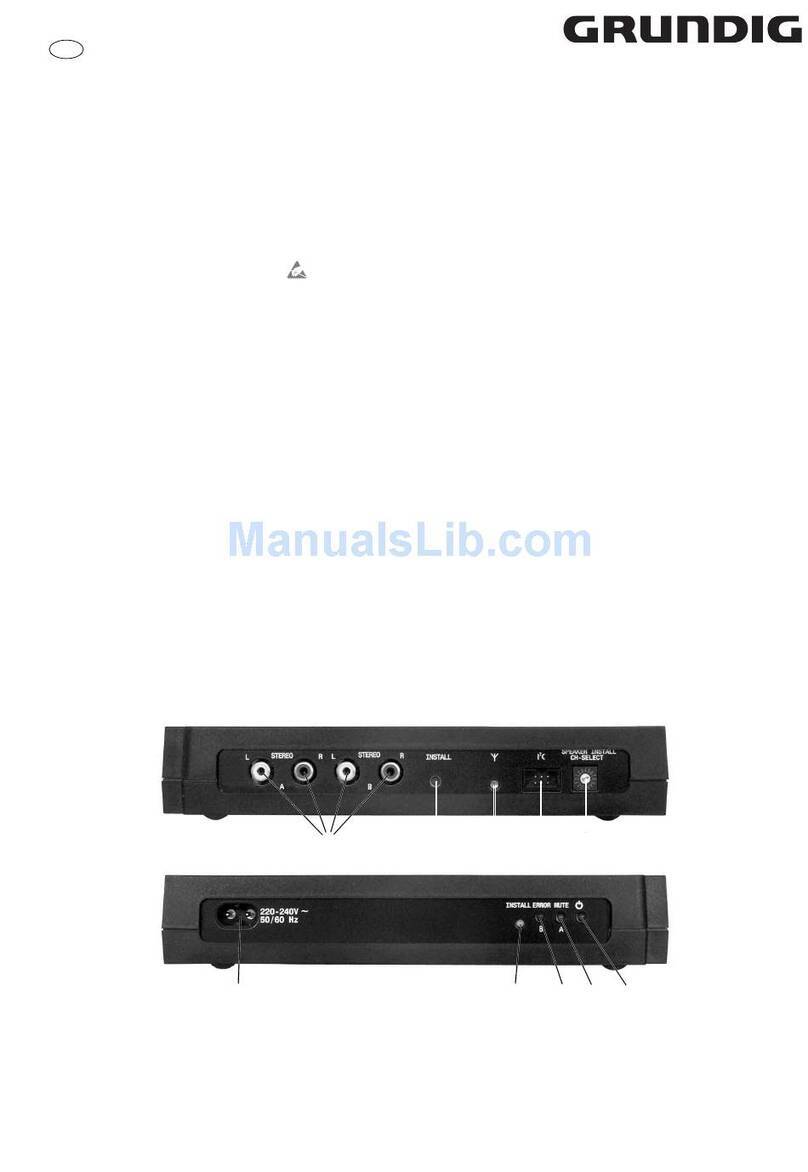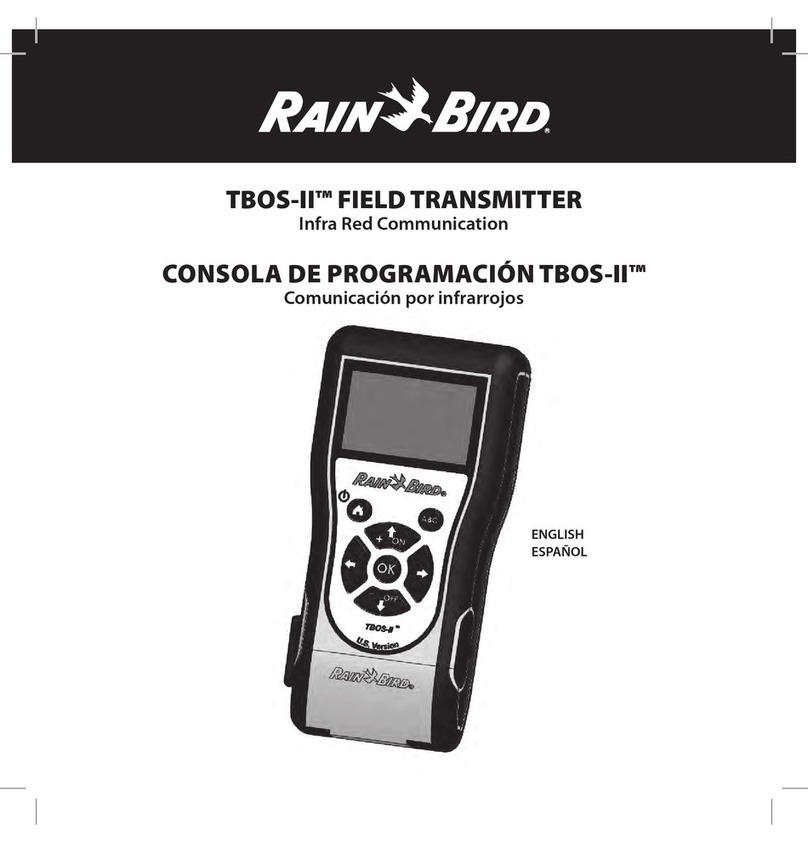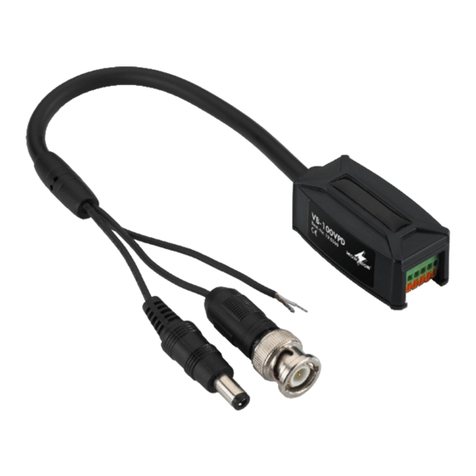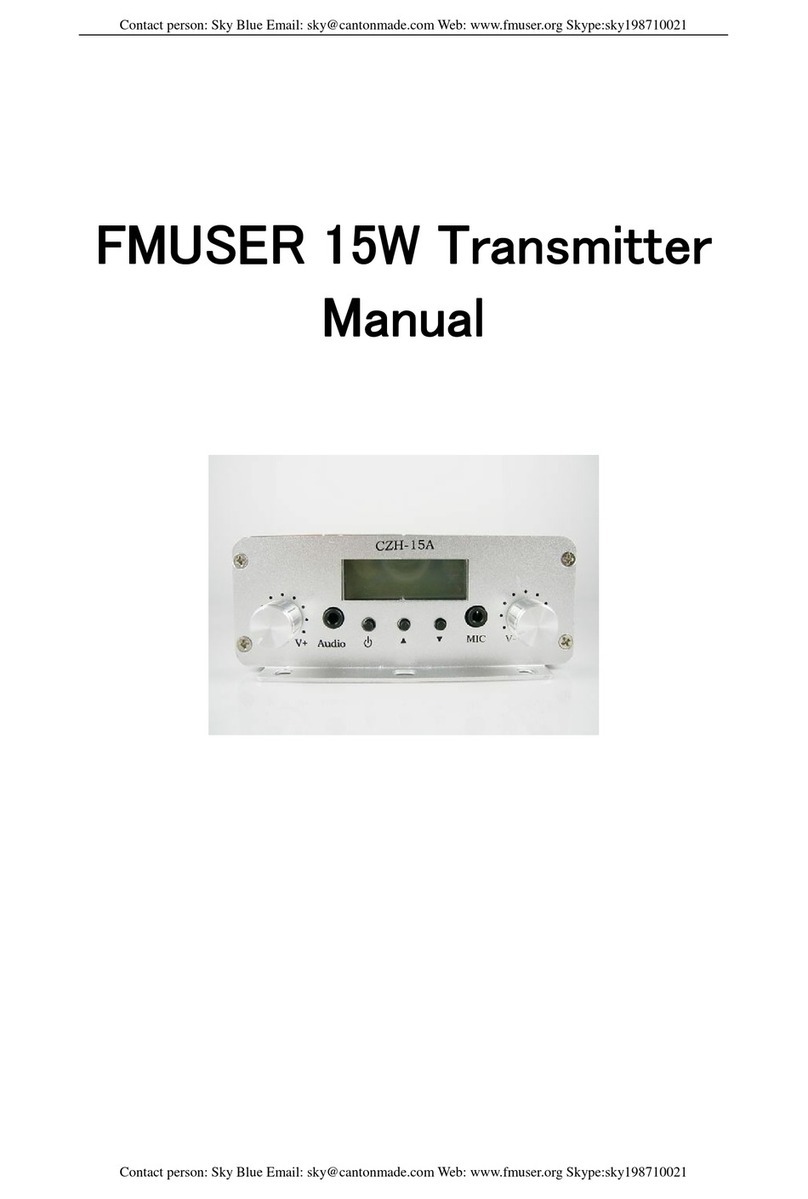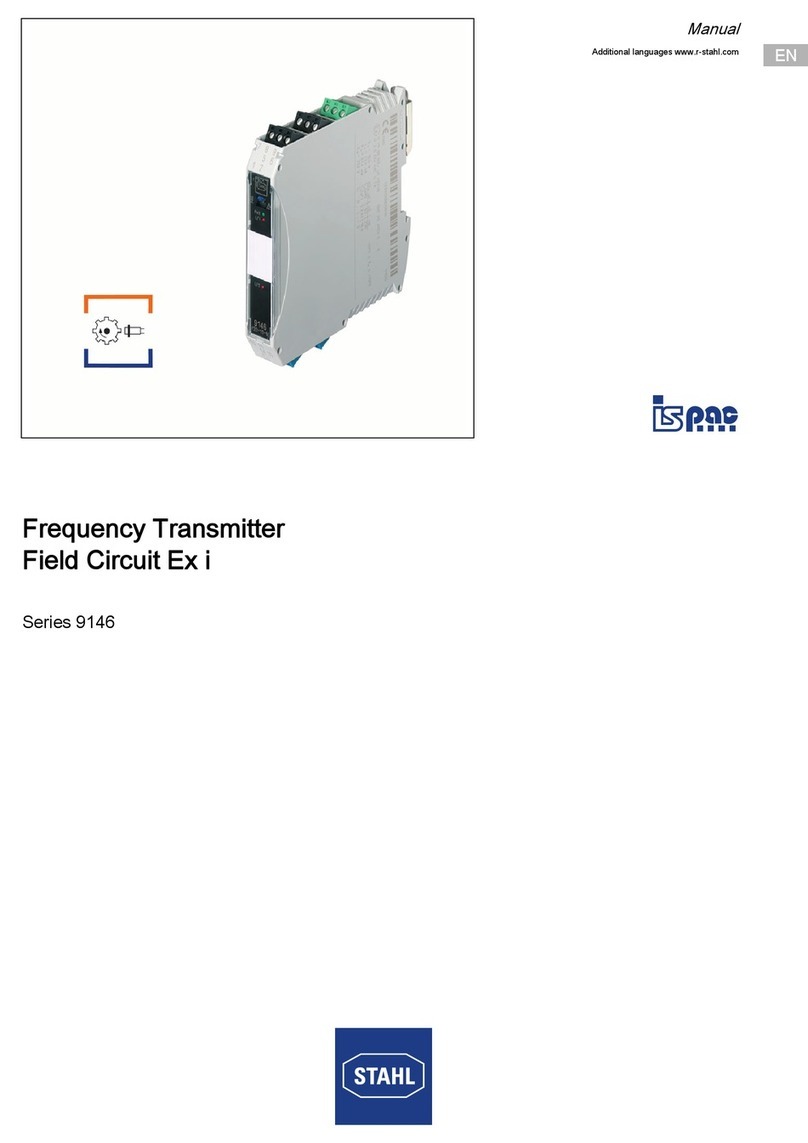Carson 501000 User manual

CARSON 6 Channel Transmitter 501000
6 Channel Transmitter with
CCPM Mixerfunction
Instruction Manual Page 1 - 14
Bedienungsanleitung Seite 15 - 28
Mode d‘emploi Page 29 - 42
Gebruiksaanwijzing Pagina 43 - 56

2CARSON 6 Channel Transmitter 501000
Dear Customer,
We congratulate you on the purchase of this LCD 6-Channel Radio Remote Control Unit.
The instructions are meant to familiarise you with the unique possibilities of this modern instrument, which is state of the art. To obtain
optimum use and much enjoyment from the system, you should carefully read through the instructions before putting it into operation.
Note that the LCD-6 is designed for easy and precise controlling of model helicopters and planes.
We wish you much success with your Radio Remote Control Unit. Enjoy using it and have fun!
Limited Warranty
This product is warranted by CARSON against manufacturing
defects in materials and workmanship under normal use for 24
months from the date of purchase from authorised franchisees
and dealers. In the event of a product defect during the warranty
period, return the product along with your receipt as proof of
purchase to any CARSON store. CARSON will, at its option,
unless otherwise provided by law:
(a) Correct the defect by repairing the product without charging
for parts and labour
(b) replace the product with one of the same or similar design;
or
(c) refund the purchase price.
All replaced parts and products, and products on which a
refund is made, become the property of CARSON. New or recon-
ditioned parts and products may be used in the performance of
warranty services. Repaired or replaced parts and products are
warranted for the remainder of the original
warranty period. You will be charged for repair or replacement
of the product made after the expiration of the warranty period.
The Warranty does not cover:
damage or failure caused by or attributable to acts of God,
abuse, accident, misuse, improper or abnormal usage, failure
to follow instructions, improper installation or maintenance,
alteration, lightning or other incidence of excess voltage or
current;
damage caused by losing control of your model;
any repairs other than those provided by a CARSON Autho-
rised Service Facility;
consumables such as fuses or batteries;
cosmetic damage;
transportation, shipping or insurance costs; or
costs of product removal, installation, set-up service adjust-
ment or reinstallation
This warranty gives you specific legal rights, and you may also
have other rights which may vary according to the country
of purchase.
●
●
●
●
●
●
●
Before using your new RC unit, be sure to read through this manual carefully.
Intended use
The 6-channel remote control system has been designed solely for private use in the model-making field and has operating times
appropriate to this use. This system is not suitable for industrial use, such as controlling machines or equipment.
Any use other than the one described above damages the product. Moreover, this involves dangers such as short-circuit,
fire, electric shock, etc.
The remote control system must not be changed technically or modified.
The safety instructions must be observed at all times!
You are solely responsible for the safe operation of the model and the remote control!
Declaration of conformity
Dickie-Tamiya GmbH&Co KG hereby declares that this radio is in accordance with the basic requirements of the following
European directives: 98/37 EG and 89/336/EWG and other relevant regulations of guideline 1999/5/EG (R&TTE).
The original declaration of conformity can be obtained from the following address:
Dickie-Tamiya GmbH&Co. KG • Werkstraße l • D-90765 Fürth • Germany

3
CARSON 6 Channel Transmitter 501000
Table of contents
Scope of delivery
Remote control transmitter
Remote control receiver
Crystal pair
Operating manual
●
●
●
●
Features
In this six-channel remote control set, you own a radio remote
control system that is ideally suited for primarily model helico-
pters and model airplanes. However, if required, you can also
use it to control model vehicles and model ships.
Its proportional control channels allow six driving, steering and
control functions to be remotely controlled independently from
one another.
The ergonomic housing fits comfortably into your hand and
allows for an easy and safe operation of the model and the
transmitter.
Operation requires 8 Mignon batteries (e.g. Carson item no.:
609000, pack of 4, 2300 mAh, order 2 x) or accumulators for
the transmitter as well as 4 mignon batteries (e.g. Carson order
number: 609000, pack of 4, 2300 mAh, order 1 x) or rechargea-
ble batteries for the transmitter.
Scope of delivery................................................................... 3
Technical Data ....................................................................... 3
Safety instructions
a) General information ......................................................4
b) Operation ......................................................................4
c) Information about batteries/rechargeable batteries ......5
Transmitter controls.............................................................. 6
a) Display ..........................................................................8
b) Controls.........................................................................8
Getting started with the transmitter .................................... 9
Commissioning the Receiver............................................. 10
Model-specific Functions ................................................... 11
a) Model A .......................................................................11
b) Model V.......................................................................11
c) Model H.......................................................................12
d) Model C.......................................................................12
e) Model C1.....................................................................13
Changing the crystal........................................................... 13
Maintenance and care......................................................... 13
Disposal................................................................................ 14
Troubleshooting .................................................................. 14
Technical Data
Transmitter
Frequency range: 35 MHz
Modulation: FM/PPM
Channel number: 6
Operating voltage: 9.6 – 12 V/DC
via 8 mignon batteries or
rechargeable batteries
Dimensions (WxHxD): 170 x 245 x 90 mm
Weight (including
rechargeable battery): appr. 640 g
Receiver
Frequency range: 35 MHz
Modulation: FM/PPM
Channel number: 6
Connector system: Futaba/Graupner JR
Operating voltage: 4.8 – 6 V/DC
via 4 mignon batteries or
rechargeable batteries
Dimensions (WxHxD): 39 x 24 x 22 mm
Weight: ca. 14 g

4CARSON 6 Channel Transmitter 501000
Safety instructions
Dear Customer, these safety instructions are not only for the protection of the product but also for your own safety and that of other
people. This is why you should read this section very carefully before using the product!
b) Operation
If you do not yet have sufcient knowledge on how to deal
with remote-controlled models, please contact an expe-
rienced model sportsman or a model construction club.
Each time before you use the product, make sure that there
are no other models operated within the same range of fre-
quency or channel as your own remote control. You might
lose the control over RC vehicles! Always use different fre-
quencies/channels.
When putting the device into operation always turn on the
transmitter rst. Do not switch on the receiver in the model
before. Otherwise, the model car can show unpredictable re-
actions. Always pull out the telescopic antenna of the trans-
mitter entirely.
Before operating the model, check whether the stationary
model reacts as expected to the commands of the remote
control.
When you operate the model, always make sure that no parts
of your body, nor other people or objects come within the
dangerous range of the motors or any other rotating drive
parts.
Improper operation can cause serious damage to people
and property! Always make sure that you have a direct eye
contact with the model and never operate it at night.
Do not operate your model if your ability to respond is re-
stricted. The inuence of tiredness, alcohol or medicine can
cause incorrect responses.
Operate your model in an area where you do not endanger
other people, animals or objects. Only operate it on private
premises or places which are specically designated for this
purpose.
In case of a fault, stop operating your model straight away
and remove the cause of malfunction before you continue to
use the model.
Do not operate your RC system during thunderstorms, under
high-voltage power lines or in the proximity of radio masts.
Always leave the remote control (transmitter) turned on, as
long as the model is in operation. For turning the model off,
always switch off the motor rst, and then switch off the re-
ceiver system. Only then can the remote control transmitter
be turned off.
Protect your model and the remote control from dampness
and bad mudding.
Do not expose your model and the remote control to direct
sunlight or excessive heat for a longer period of time.
In the case of low batteries (or rechargeable batteries) in the
remote control, the range decreases. If the battery in the re-
ceiver is low, the model does not react correctly to the com-
mands of the remote control any more.
If this is the case, stop the operation immediately. You should
then replace the batteries by new ones or recharge the (re-
chargeable) batteries.
Do not take any risks when operating the product! Your own
safety and that of your environment is solely down to you
being responsible when dealing with the model.
●
●
●
●
●
●
●
●
●
●
●
●
●
●
●
●
a) General information
The operation and the handling of RC models must be learned!
If you have never steered such a model, start especially carefully
and get used to the reactions of the model to the remote control
commands first. Be patient!
The product is not a toy and should be kept out of reach of
children under 14 years of age.
Taking out a private liability insurance is recommended. If you
already have one, inform yourself whether the operation of an
RC model is covered by your insurance.
Each time before you use the model, please check the func-
tional safety of your model and of the remote control system.
Pay attention to visible damages such as broken plug-in con-
nections or damaged cables. All movable parts on the model
have to be smooth-running, but there must be no tolerance
in the bearing.
Do not connect the drive motor to electric models before the
receiver system has been completely installed to avoid the
drive motor starting before you are ready.
The unauthorized conversion and/or modication of the pro-
duct is inadmissible because of safety and approval reasons
(CE).
The product must not get damp or wet.
Do not leave packaging material unattended. It may become
dangerous playing material for children!
Should technical questions arise that are not answered with
the help of these operating instructions, please contact us
(for contact information, see Section 1) or ask an expert.
●
●
●
●
●
●
●
●

5
CARSON 6 Channel Transmitter 501000
c) Information about batteries/rechargeable
batteries
Keep batteries out of reach of children.
Do not let batteries lie around openly. There is a risk of batte-
ries being swallowed by children or pets. In such a case, seek
instant medical care!
Batteries/rechargeable batteries must never be short-circui-
ted, taken apart or thrown into re. They might explode!
Leaking or damaged batteries/rechargeable batteries might
cause acid burns when getting into contact with skin, there-
fore, use suitable protective gloves.
Conventional batteries must not be re-charged. Danger of re
and explosion! Only charge rechargeable batteries which are
intended for this purpose; use suitable battery chargers.
Please observe correct polarity (positive/+ and negative/-)
when inserting the batteries/rechargeable batteries.
If the device is not used for a longer period of time (e.g. du-
ring storage), take out the batteries/rechargeable batteries
inserted in the remote control and in the car to avoid damage
from leaking batteries.
Recharge the rechargeable battery about every 3 months, as
otherwise there may a so-called deep discharge due to the
self-discharge, which makes rechargeable batteries useless.
Always exchange the entire set of batteries. Do not mix full
batteries/rechargeable batteries with half-full ones. Always
use batteries or rechargeable batteries of the same type and
manufacturer.
Never mix conventional and rechargeable batteries! Either
use batteries or rechargeable batteries for the remote con-
trol.
It is possible to operate the remote control (transmitter) with
rechargeable batteries instead of conventional batteries.
●
●
●
●
●
●
●
●
●
●
●
However, the lower voltage (batteries=1.5 V, rechargeable
batteries=1.2 V) and the lower capacity of rechargeable bat-
teries lead to a decrease in the operating time. Usually this
does not matter, since the operating time of the transmitter is
much longer than that of the model.
If you use conventional batteries in the remote control, we
recommend the use of high-quality alkaline batteries.
When using rechargeable batteries the range might be red-
uced.
The rechargeable mignon batteries required for the RC sy-
stem are, in general, empty on delivery and must be char-
ged.
Please note:
Before the rechargeable battery supplies its maximum
power, several complete discharge and charge cycles are
necessary.
Always discharge the rechargeable battery in regular inter-
vals, since charging a ”half-full” rechargeable battery seve-
ral times can cause a so-called memory effect. This means
that the rechargeable battery loses its capacity. It no longer
releases all of its stored energy, the operation time of the
model and the transmitter is reduced.
If you use several rechargeable batteries, purchasing a high-
quality charger may be worthwhile. They are normally also sui-
table for fast-charging rechargeable batteries.
Take note of the about paragraph when charging the batteries
in the transmitter.
ATTENTION!
Only charge rechargeable batteries which are intended for
this purpose!
Take note of the separate operating manuals of accessories
such as rechargeable batteries and chargers.
●
●
●
●

6CARSON 6 Channel Transmitter 501000
1 Transmitter antenna
2 LC display
3 Rotary Controller 1
MODELS A & V: Travel limit for Function Channels 1, 2 & 4
4 Rotary Controller 2
MODEL A: Flaperon/fowler flaps
MODEL V: Aileron travel
MODELS H, C & C1: Pitch travel
For Aircraft Models H, C and C1, Rotary Controllers 1 and 2
can be used to adjust the pitch curve.
Both rotary controllers can be locked with the LOCK slide
switch.
5 Toggle Switch 1, Function Channel 5 (available) for supple-
mentary functions
6 Toggle Switch2 (3D switch for aerobatics)
MODEL A: Simulaton of fowler flaps
MODEL V: Supplementary functions
MODELS H, C & C1: Idle running with the throttle/pitch control
lever in mid-position
WARNING! When Models H, C or C1 are selected, you may
only switch into 3D operation while the gas/pitch lever is
in the mid-position.
7 Toggle Switch 3, dual-rate Function Channels 1, 2 & 4
Reduction of Functional Travels 1, 2 and 4 from 100% (Pos. 0)
to 70% (Pos. 1)
8 „MODEL“ pushbutton for selecting the aircraft model
desired
9 LED (green) indicates the switching status
10 LED (red) indicates undervoltage
Replace the rechargeable batteries for the transmitter as soon
as the red LED begins to blink, or when the LCD display goes
off at the very latest.
11 Remote control lever (Function Channels 3 and 4)
12 Remote control lever (Function Channels 2 and 1)
Both remote control levers can be extended by approx 5 mm.
13 Trim Function Channel 3
14 Trim Function Channel 4
15 Trim Function Channel 2
16 Trim Function Channel 1
17 Ring for carrying strap
18 On/Off switch
WARNING! With MODELS H, C or C1 are preselected, the 3D
switch (Toggle Switch 2) has to be on „NOR“ when the trans-
mitter is switched on.
19 LOCK slide switch for locking the rotary controllers and the
MODEL pushbutton
20 Reverse switch, Function Channels 1, 2, 3, 4 & 6
Bottom: NOR (normal), top: REV (reverse)
21 Handle
22 Transmitter quartz (Rear side of the transmitter)
23 Connector socket for flight simulator
24 (rechargeable) battery compartment
25 Charging socket (Side of the transmitter)
Transmitter
controls

7
CARSON 6 Channel Transmitter 501000

8CARSON 6 Channel Transmitter 501000
a) Display
The most important information on the current settings is shown
on the LC display.
Timer:
Shows the time since the transmitter was last switched on.
MODEL:
(A, V, H, C, C1)
The aircraft model preset is indicated.
CH:
Indication of the NOR (normal) or REV (reverse) position for the
function channels
LOCK:
This is displayed when the rotary controllers or the MODEL
pushbutton are locked.
V:
Voltage indication for the rechargeable batteries for the trans-
mitter
b) Controls
Function channels
A function channel stands for the function assigned to a remote
control lever or other control, such as gas/pitch, aileron, rudder,
etc. Under some circumstances, such functions may be perfor-
med by multiple servos simultaneously.
Depending on the aircraft model (MODEL A, V, H, C or C1), the
same function channel may have different functions/effects on a
particular model.
By contrast, the direct assignment of a channel on a receiver to
an individual servo (and thus the effect of that individual servo
on the model) is called a servo channel.
Undervoltage indicator (10)
In addition to the digital voltage indication on the display, the
transmitter also has a red LED that starts blinking when voltage
of 8.5 V is fallen short of. So as not to lose control of the model,
immediately end the flight operation and either charge or replace
the batteries with fully charged ones.
WARNING! Only rechargeable batteries may be used.
If the voltage drops below 7.6 V, the LC display goes out, and
the LED continues to blink.
Now at the latest you must land the model and replace the bat-
teries.
Toggle Switch Channel 5 (5)
The left toggle switch is assigned to Function Channel and Servo
Channel 5 and has purely switching functions.
This can be used for any supplementary function desired, such
as retracting and lowering retractable landing gear with model
planes or switching a gyro from normal mode into head-lock
mode.
This Channel 5 does not have a reverse switch.
Toggle switch, dual-rate (7)
The right toggle switch in the front simultaneously has an effect
on Function Channels 1, 2 and 4.
As a result, the effect of Functions 1,2 and 4 on the model are
reduced from 100% (Position „0“) to 70% (Position „1“). This
allows more delicate control of the model, because the maxi-
mum mechanical lever travel remains available for the control
system.
The dual-rate adjustment also has an effect on the influence
exerted by the trim controls.
Trim controls for Function Channels 1, 2, 3 and 4 (13) - (16)
The trim control of a function channel shifts the mid-position of
all the servos that are responsible for performing the function
assigned. This trimming is carried out purely mechanically. If
dual-rate is switched on after the model is trimmed, the degree
of trimming is also reduced to 70%.
Connector socket for flight simulator (23)
The remote control transmitter can also be used to control PC
games or for flight training with a flight simulation program. The
control system data is transmitted via a connection cable from
your transmitter directly to the PC.
This way valuable experience can be gained for real flights,
while going easy on your equipment.
Lock (19)
After making the basic settings for the transmitter, the slide
switch can be used to secure the model selection (MODEL push-
button) and the two rotary controllers against any unintended
switching. A pointed object (such as a small screwdriver, pin,
etc) is required to do the switching. This ensures that the locking
cannot be accidently undone during flight operation.

9
CARSON 6 Channel Transmitter 501000
Model (8)
Use the pushbutton to scroll through a list of pre-set aircraft
models and select the aircraft model being used. The function
channels are assigned specific functions depending on the air-
craft model selected, as described in the following:
Selection available:
MODEL A: For model planes with ailerons
MODEL V: For model planes with V-tails or for delta-win-
ged aircraft
MODEL H: For helicopters with mixed mechanical func-
tions.
Each function is performed separately by one
servo, having an effect on the model via rod
assemblies and deflections.
MODEL C: For helicopters with a CCPM (collective cyclic
pitch mix) triggering system.
The transmitter‘s 120° CCPM mixer simulta-
neously controls in proportionate fashion the
three servos staggered by 120° acting directly
upon the swash plate, doing so for roll and
pitch functions.
MODEL C1: Like MODEL C, with reverse direction of
pitch (built-in variant, head servo at the
rear when looking toward the direction of
flight)
Getting started with the transmitter
Inserting the batteries/rechargeable batteries
The power supply of the transmitter requires 8 alkaline batteries
(e.g. Carson item no.: 609000, pack of 4, order 2 x) or accumu-
lators size Mignon (AA). For ecological and also for economical
reasons it is recommended to use rechargeable batteries, since
they can be recharged in the transmitter via a built-in charging
socket.
Adjustment of length of the remote control levers
The length of the remote control levers can be adjusted by
approx 5 mm. To do so, turn the top part (1) of the remote control
lever counter-clockwise on the threaded control stick until the
desired length is reached. Lock this position by turning the lower
part of the remote control lever (2) against this.
Be sure that the lever is still screwed at least 3-4 mm on the
threaded control stick.
To insert the batteries or rechargeable batteries, proceed
as follows:
The battery compartment lid (1) is located on the bottom of
the transmitter. Please press the corrugated triangle (2) and
push off the cover.
Now insert the eight batteries or rechargeable batteries in the
battery compartment. Pay attention to the correct polarity of
the cells. The negative pole (housing) of the battery or re-
chargeable battery must have contact with the spiral spring.
A corresponding notice (3) is located on the bottom of the
battery compartment.
Afterwards slide the lid of the battery compartment back on
and let the locking mechanism click into place.
●
●
●
●

10 CARSON 6 Channel Transmitter 501000
Loading the rechargeable batteries for the transmitter
Switch off the transmitter and connect a suitable charging
cable (not included in the scope of supply) to the charging
socket.
ATTENTION! Connect the charger only if the rechargeable
batteries are inserted in the transmitter!
Conventional batteries (1.5V) must not be charged any
more, there is a risk of fire and explosion!
Only charge rechargeable batteries intended for that purpo-
se!
When connecting a charge cable, imperatively observe the
correct polarity of the connecting plug. The inner contact of
the charge socket has to be connected to the minus connec-
tion (-) and the outside contact to the plus connection (+) of
the charger.
The charging current should be approx. 1/10 of the capacity
value of the inserted rechargeable batteries. With rechargea-
ble batteries with a capacity of 2000mAh this corresponds to
a charging current of approx. 200mA and the charging time is
approx. 14 hours.d
Do not use any quick-chargers in order to avoid any damages
to the internal strip conductors and connections.
No chargers can be used that briey interrupt the charging
current in order to measure the current rechargeable battery
voltage.
A protective diode in the charging current circuit of the trans-
mitter acts as a free battery connection when the charging
current is switched off; thus, the voltage cannot be measured.
For such chargers, the rechargeable batteries must be char-
ged outside the transmitter.
With NiCd rechargeable batteries a memory effect can occur.
If NiCd rechargeable batteries are charged when they are not
fully discharged, their capacity diminishes in the course of
time. Thus, such rechargeable batteries must be discharged
with an appropriate charger outside of the transmitter and
then charged completely again.
●
●
●
●
●
●
●
●
Switching on the transmitter
When the rechargeable batteries are charged or when new
batteries are inserted, pull out the antenna of the transmitter
all the way and, for test purposes, switch the transmitter on
via the function switch (see gure 1, Pos. 13).
To do so, slide the control button from the bottom to the top
(slanted). The green battery control LED (see gure 1, pos.
9) lights up briey and a short beep tone signals adequate
power supply of the transmitter.
If the voltage supply falls below 8.5 V, the red LED starts
blinking to indicate undervoltage. In this case, you should
stop operating your model as quickly as possible. For further
operation of the transmitter the rechargeable batteries have
to be recharged or new batteries have to be inserted. To pre-
vent this scenario, you should stop operating your transmitter
when the supply voltage drops to 9.0 V.
In order to avoid the memory effect of NiCd rechargeable bat-
teries, you should connect the charger only when the rechar-
geable batteries are completely discharged.
●
●
●
●
Commissioning the Receiver
Receiver connection
The receiver allows you to connect up to 6 servos and a receiver
accumulator, which are equipped with Futaba/JR connectors
(with reverse polarity protection). To simultaneously connect six
servos and one rechargeable receiver battery, an additional Y-
cable is necessary (not included).
When connecting servos and drive controls, always make
sure to pay close attention to the correct polarity of the plug
connectors.
The wrap connection for the positive lead (yellow, white or
orange, depending on the manufacturer) must be connected
to the inner pin contact. The wrap connection for the negative
lead (black or brown, depending on the manufacturer) must
be connected to the outer pin contact.
Depending on the model for which you use the remote control
system, the connection as well as the power supply of the
receiver and the servos can be effected in different ways.
Installing the receiver
The installation of the receiver depends on the model. For this
reason, you should always follow the recommendations of the
model manufacturer regarding receiver installation. Regardless
of the model, you should always try to install the receiver so that
it is protected from dust, dirt, moisture and vibration in the best
possible way. Two-sided adhesive foam (servo tape) or even
rubber rings that hold the foam-wrapped receiver securely in
place are suitable for fastening.
●
●
●
Warning!
The length of the aerial wire (1) has a precisely determined
length. Therefore the aerial wire must not be wound up,
wrapped up or cut. This would decrease the range signifi-
cantly and thus pose a considerable safety risk.
Feed the aerial wire out of the model through an opening in the
body directly behind the receiver. To do so, you should
ideally use an aerial tube, which may be supplied with the model
or which can be obtained as an accessory.

11
CARSON 6 Channel Transmitter 501000
Installing the servos
The installation of a servo is always dependent on the particular
model used. For specific information, refer to the design docu-
ments of the model. However, generally you should try to fasten
the servos with screws in such a way that vibrations are minimi-
sed. For this purpose, servos are typically supplied with rubber
bushings with metal sleeves.
Checking the control functions
Connect the servos and/or speed controllers and the power
supply to the receiver.
Switch on the transmitter and then the receiver. If you have
connected everything correctly, all the servos should respond
correctly.
If one or more functions should not respond correctly, then you
can correct the relevant adjustments.
Model-specic Functions
a) Model A
Model plane with aileron
Remote control lever, left forward/backward Servo Channel 3 Gas
right/left Servo Channel 4 Rudder
Remote control lever, right forward/backward Servo Channel 2 Elevator
right/left Servo Channel 1 & 6 Aileron
Reverse switch 1 Both ailerons
2, 3, 4 Elevator servo / gas servo / rudder servo
Rotary Controller 1 Servo travel adjustment for Function Channels 1, 2 and 4 Reduction to 1/6 of the maximum control
travel
Toggle Switch 2: „Flaperon“ (flap + aileron) / fowler flap adjustment
The mid-position of the aileron servo adjusts in the oppo-
site direction, such that the ailerons no longer meet flush
with the surface, but rather, both deflected in the same
direction, simulate a fowler flap (flaperon). The actual aile-
ron function is maintained when this is done.
Rotary Controller 2 Deflecting the ailerons (fowler flaps) from the mid-positi-
on.
Reverse Switch 6 Fowler flaps upward or downward, as desired
b) Model V
Model plane with V-tail
Remote control lever, left forward/backward Servo Channel 3 Gas
right/left Servo Channel 4 Aileron
Remote control lever, right forward/backward Servo Channels 1 & 2 Elevators
moving in same direction
right/left Servo Channels 1 & 2 Rudders
moving in opposite directions
Reverse Switches 1, 2, 3 & 4
Rotary Controller 1 Servo travel adjustment, Channels 1 & 2
Reduction to 1/6 of the maximum control travel
Rotary Controller 2 Servo travel adjustment, Servo Channel 4
Toggle Switch 1 Free switch (Receiver Channel 5)
Toggle Switch 2 Free switch (Receiver Channel 6)
No „Flaperon“ (flap + aileron) / fowler flap adjustment is possible, because the
aileron is only triggered by one servo.
Delta-winged aircraft
Remote control lever, left forward/backward Servo Channel 3 Gas
right/left Servo Channel 4 Rudder
Remote control lever, right forward/backward Servo Channels 1 & 2 Elevators
moving in same direction
right/left Servo Channels 1 & 2 Ailerons
moving in opposite directions

12 CARSON 6 Channel Transmitter 501000
c) Model H
Helicopter model, mechanical mixer
Remote control lever, left forward/backward Servo Channels 3 & 6 Gas/Pitch
Servo channel 3 (gas)
from idle running to full speed
right/left Servo Channel 4 Tail
Remote control lever, right forward/backward Servo Channel 2 Pitch
right/left Servo Channel 1 Roll
Reverse Switches 1, 2, 4 & 6 All functions
3 Idle running position, top/bottom
Rotary Controllers 1 & 2 Adjusting the pitch curve. Pitch travel is reduced on the
remote control lever so as to also allow full servo
travels with the trimming on Rotary Controller 1.
Rotary Controller 1 Pitch trimming of the Helicopter/position of the control lever around the mid-position during hover flight
of the Helicopter (which shifts the zero crossing of the pitch curve)
Rotary Controller 2 Influence of the gas/pitch lever on the pitch function (servo channel 6), (which changes the inclination
of the pitch curve).
Toggle Switch 1 Recommended for gyro: Norm/head-lock switching
Toggle Switch 2 (3D mode) The gas servo (3) goes to full speed at both full deflections of the remote control lever.
Mid-position: half speed (no idle running position)
Large servo travel for pitch: The entire pitch travel is available directly on the control lever so as to
enable more extreme flight manoeuvres.
Rotary Controllers 1 & 2: No function
WARNING! Only near the mid-position of the gas/pitch lever should you switch over into the 3D mode. When changing out
of the idle running position, the motor starts running too fast.
d) Model C
Helicopter model, CCPM (collective cyclic pitch mix)
The transmitter‘s 120° CCPM mixer simultaneously controls in proportionate fashion the three servos staggered by 120° acting direct-
ly upon the swash plate, doing so for roll and pitch functions. Select the „Model C“ setting if the head servo (pitch) is at the front when
looking toward the direction of flight.
Remote control lever, left forward/backward Servo Channel 3 Gas
Servo Channels 1 & 2 & 6 Pitch
right/left Servo Channel 4 Tail
Remote control lever, right forward/backward Servo Channels 1 & 2 & 6 Pitch
right/left Servo Channels 1 & 6 Roll
Toggle Switch 1 Recommended for gyro: Norm/head-lock switching
Reverse Switch 1 Roll
Reverse Switch 2 Pitch
Reverse Switch 3 Gas (idle running position, top/bottom)
Reverse Switch 4 Tail
Reverse Switch 6 Pitch
Rotary Controllers 1 & 2 Adjusting the pitch curve. Pitch travel is reduced on the
remote control lever so as to also allow full servo
travels with the trimming on Rotary Controller 1.
Rotary Controller 1 Pitch trimming of the Helicopter/position of the control
lever for hover flight (which shifts the zero crossing of the pitch curve)
Rotary Controller 2 Influence of the gas/pitch lever on the pitch function (servo channel 6), (which changes the inclination
of the pitch curve).
Toggle Switch 1 Recommended for gyro: Norm/head-lock switching
Toggle Switch 2 (3D mode) The gas servo (3) goes to full speed at both full deflections of the remote control lever.
Mid-position: half speed (no idle running position)
Large pitch travel: The entire pitch travel is available directly on the control lever so as to enable more
extreme flight manoeuvres.
Rotary Controllers 1 & 2: No function
WARNING! Only near the mid-position of the gas/pitch lever should you switch over into the 3D mode. When changing out
of the idle running position, the motor starts running too fast.

13
CARSON 6 Channel Transmitter 501000
Changing the crystal
In order to avoid a double assignment of a channel it may
be necessary to change the crystals on your remote control
system.
For reasons of operational safety, you should only use cry-
stals that are explicitly recommended for the use in your
remote control system by the manufacturer.
To change the crystal, proceed as follows:
With the transmitter turned off, pull the holder for the trans-
mitter crystal (1) on the back of the transmitter crystal out of
the housing.
Take the transmitter crystal out of its plastic holder.
Insert a transmitter crystal with a different channel in the
same frequency band. Please make sure that you place the
correct crystal in the holder. Transmitter crystals are normally
marked with the letter T or TX (T = ”transmitter”).
Put the crystal holder (1) back into the transmitter.
Switch the receiver system off and remove the crystal (2)
from the plug-in socket in the receiver.
The suitable crystal for the receiver has to be marked with the
same channel number as the transmitter crystal. In addition it is
marked with the code R or RX (R = receiver).
Insert the receiver crystal with the suitable frequency for the
transmitter into the receiver.
Switch on the transmitter and afterwards the receiver and
check the functioning of the system.
●
●
●
●
●
●
●
Maintenance and care
Clean the exterior of the remote control only with a clean, soft, dry cloth. Never use aggressive cleansing agents or chemical solutions,
because they might damage the surface of the housing.
Remove dust with a soft, clean brush.
e) Model C1
Helicopter model, CCPM
Same functions and allocation as „Model C“.
Select the „Model C1“ setting if the head servo (pitch) is at the rear, when looking toward
the direction of flight.

14 CARSON 6 Channel Transmitter 501000
Disposal
General information
At the end of its service life, dispose of the product according to the relevant statutory regulations.
Batteries and rechargeable batteries
The user is legally obliged (Battery Regulation) to return used batteries and rechargeable batteries. Do not dispose of used
batteries in the domestic waste.
Batteries/storage batteries containing hazardous substances are marked with the following symbols indicating that they are
must not be disposed of in the domestic waste. The markings for hazardous heavy metals are: Cd=cadmium, Hg=mercury,
Pb=lead (name on battery/rechargeable battery, e.g. under the trash icons on the left).
You can return used batteries/rechargeable batteries free of charge to any collecting point in your local community, in our
stores or in any other store where batteries/rechargeable batteries are sold.
Thus, you comply with legal obligations and contribute to environmental protection.
Troubleshooting
Even though the remote control system was designed as a state-of-the-art product, there can still be malfunctions or faults. This is
why we would like to show you how to clear possible malfunctions.
Problem Remedy
The transmitter does not
respond.
Check the batteries or rechargeable batteries of the transmitter.
Check the polarity of the batteries or rechargeable batteries.
Check the function switch.
The servos do not react. Check the batteries or rechargeable batteries of the receiver.
Test the connecting cable.
Check the BEC function of the control unit
Check the polarity of the servo connector.
Check the markings on the crystals.
Change the crystal to a different channel.
Exchange the receiver for test purposes.
The gas servo does not
respond in the Helicopter
model.
Check the 3D switch. This switch has to be in the OFF position when the trans-
mitter is switched on.
The servos shake. Check the batteries or rechargeable batteries of the transmitter and the model.
Change the crystal to a different channel.
Carefully dry possible dampness in the receiver with a blow-dryer.
Check the receiver antenna for damages and electrical continuity.
Install the receiver antenna in the model differently for test purposes.
A servo is humming. Check the batteries or rechargeable batteries of the receiver.
Check that the linkage rods are running smoothly.
Operate the servo without a rudder horn for test purposes.
The system has only a low
range.
Pull out the transmitter antenna to its full length.
Check the batteries or rechargeable batteries of the transmitter and the model.
Check the receiver antenna for damages and electrical continuity.
Install the receiver antenna in the model differently for test purposes.
The transmitter turns off
straight away or after a
short while.
Check the batteries or rechargeable batteries of the transmitter or replace
them.

CARSON 6 Channel Transmitter 501000
6 Channel Transmitter with
CCPM Mixerfunction
Bedienungsanleitung Seite 15 - 28

16 CARSON 6 Channel Transmitter 501000
Sehr geehrter Kunde
Wir beglückwünschen Sie zum Kauf dieser LCD-6 Kanal Funkfernsteuerung.
Die Anleitung soll Sie mit den einzigartigen Möglichkeiten dieses modernen Geräts nach neuestem Stand der Technik vertraut ma-
chen. Um beim Einsatz der Anlage optimalen Nutzen und viel Freude zu erfahren, sollten Sie die Anleitung vor Inbetriebnahme sorgfäl-
tig lesen. Beachten Sie bitte, dass die LCD-6 Kanal Funkfernsteuerung auf eine leichte und präzise Steuerung von Modellhelikoptern
und -Fliegern ausgelegt ist.
Wir wünschen Ihnen viel Erfolg mit Ihrer Funkfernsteuerung, genießen Sie deren Einsatz und viel Spaß!
Garantiebedingungen
Für dieses Produkt leistet CARSON eine Garantie von 24
Monaten betreffend Fehler bei der Herstellung in Bezug auf
Material und Fertigung bei normalem Gebrauch ab dem Kauf
beim autorisierten Fachhändler. Im Falle eines Defekts während
der Garantiezeit bringen Sie das Modell zusammen mit dem
Kaufbeleg zu Ihrem Fachhändler.
CARSON wird nach eigener Entscheidung, falls nicht anders im
Gesetz vorgesehen:
(a) den Defekt durch Reparatur kostenlos in Bezug auf Material
und Arbeit beheben;
(b) das Produkt durch ein gleichartiges oder im Aufbau ähnliches
ersetzen; oder
(c) den Kaufpreis erstatten.
Alle ersetzten Teile und Produkte, für die Ersatz geleistet wird,
werden zum Eigentum von CARSON. Im Rahmen der
Garantieleistungen dürfen neue oder wiederaufbereitete Teile
verwendet werden.
Auf reparierte oder ersetzte Teile gilt eine Garantie für die
Restlaufzeit der ursprünglichen Garantiefrist. Nach Ablauf
der Garantiefrist vorgenommene Reparaturen oder gelieferte
Ersatzteile werden in Rechnung gestellt.
Von der Garantie ausgeschlossen sind:
Beschädigung oder Ausfall durch Nichtbeachten der Sicher-
heitsanweisungen oder der Bedienungsanleitung, höhere
Gewalt, Unfall, fehlerhafte oder außergewöhnliche Bean-
spruchung, fehlerhafte Handhabung, eigenmächtige Verän-
derungen, Blitzschlag oder anderer Einuss von Hochspan-
nung oder Strom.
Schäden, die durch den Verlust der Kontrolle über Ihr Modell
entstehen.
Reparaturen, die nicht durch einen autorisierten CARSON-
Service durchgeführt wurden
Verschleißteile wie etwa Sicherungen und Batterien
rein optische Beeinträchtigungen
Transport-, Versand- oder Versicherungskosten
Kosten für die Entsorgung des Produkts sowie Einrichten
und vom Service vorgenommene Einstell- und Wiederein-
richtungsarbeiten.
Durch diese Garantie erhalten Sie spezielle Rechte, darüber
hinaus ist auch eine von Land zu Land verschiedene
Geltendmachung anderer Ansprüche denkbar.
●
●
●
●
●
●
●
●
Vor dem Gebrauch Ihrer neuen Fernsteueranlage lesen Sie bitte dieses Handbuch
sorgfältig durch!
Bestimmungsgemäße Verwendung
Die 6-Kanal Fernsteuerung ist ausschließlich für den privaten Einsatz im Modellbaubereich mit den damit verbundenen Betriebszeiten
ausgelegt. Für einen industriellen Einsatz, z.B. zur Steuerung von Maschinen oder Anlagen, ist dieses System nicht geeignet.
Eine andere Verwendung als zuvor beschrieben, kann zur Beschädigung des Produktes mit den damit verbundenen
Gefahren wie z.B. Kurzschluss, Brand, elektrischer Schlag etc. führen.
Die Fernsteueranlage darf technisch nicht verändert bzw. umgebaut werden!
Die Sicherheitshinweise sind unbedingt zu befolgen!
Sie allein sind für den gefahrlosen Betrieb Ihrer Fernsteuerung und Ihres Modells verantwortlich!
Konformitätserklärung
Hiermit erklärt CARSON MODEL-SPORT, dass sich diese Fernsteueranlage in Übereinstimmung mit den grundlegenden Anforde-
rungen und den anderen relevanten Vorschriften der Richtlinie 1999/5/EG (R&TTE) bendet.
Die Original-Konformitätserklärung kann angefordert werden:
Dickie-Tamiya GmbH&Co. KG • Werkstraße l • D-90765 Fürth • Tel.: +49/(0)911/9765-03

17
CARSON 6 Channel Transmitter 501000
Inhalt
Lieferumfang
Fernsteuersender
Fernsteuerempfänger
Quarzpaar
Bedienungsanleitung
●
●
●
●
Features
Mit dem 6-Kanal Fernsteuerungs-Set besitzen Sie ein Funk-
fernsteuersystem, das in erster Linie ideal für Modellhelikopter
und Modellflugzeuge geeignet ist. Sie können bei Bedarf aber
auch Modellfahrzeuge und Modellschiffe damit steuern.
Über die proportionalen Funktionskanäle sind 6 Fahr-, Lenk,-
und Steuerfunktionen unabhängig voneinander fernbedienbar.
Das ergonomisch geformte Gehäuse liegt komfortabel in der
Hand und ermöglicht so eine bequeme Bedienung des Senders
und eine sichere Steuerung des Modells.
Zum Betrieb sind noch 8 Mignon-Batterien oder Akkus für
den Sender, sowie 4 Mignon-Batterien oder Akkus für den
Empfänger erforderlich (Best. Nr. 609000 4er Set Mignon Akkus
2300 mAh).
Lieferumfang.......................................................................... 3
Technische Daten.................................................................. 3
Sicherheitsanweisungen ...................................................... 4
a) Allgemein ......................................................................4
b) Betrieb...........................................................................4
c) Batterie- und Akkuhinweise...........................................5
Bedienelemente des Senders .............................................. 6
a) Display ..........................................................................8
b) Bedienelemente ............................................................8
Inbetriebnahme des Senders ............................................... 9
Inbetriebnahme des Empfängers....................................... 10
Modellspezifische Funktionen ........................................... 11
a) Model A ....................................................................... 11
b) Model V.......................................................................11
c) Model H.......................................................................12
d) Model C.......................................................................12
e) Model C1.....................................................................13
Quarzwechsel ...................................................................... 13
Wartung und Pflege ............................................................ 13
Entsorgung .......................................................................... 14
Behebung von Störungen .................................................. 14
Technische Daten
Sender
Frequenzbereich: 35 MHz
Modulation: FM/PPM
Kanalzahl: 6
Betriebsspannung: 9,6 – 12 V/DC
über 8 Mignon-Batterien
oder Akkus
Abmessungen (B x H x T): 170 x 245 x 90 mm
Gewicht inkl. Akkus: ca. 640 g
Empfänger
Frequenzbereich: 35 MHz
Modulation: FM/PPM
Kanalzahl: 6
Stecksystem: Futaba/Graupner JR
Betriebsspannung: 4,8 - 6 V/DC
über 4 Mignon-Batterien
oder Akkus
Abmessungen (B x H x T): 39 x 24 x 22 mm
Gewicht: ca. 14 g

18 CARSON 6 Channel Transmitter 501000
Sicherheitsanweisungen
Sehr geehrte Kundin, sehr geehrter Kunde, diese Sicherheitshinweise dienen nicht nur zum Schutz des Produkts, sondern auch zu
Ihrer eigenen Sicherheit und der anderer Personen. Lesen Sie sich deshalb dieses Kapitel sehr aufmerksam durch, bevor Sie das
Produkt in Betrieb nehmen!
b) Betrieb
Sollten Sie noch nicht über ausreichende Kenntnisse über
den Umgang mit ferngesteuerten Modellen verfügen, so
wenden Sie sich an einen erfahrenen Modellsportler oder an
einen Modellbau-Club.
Stellen Sie vor jeder Inbetriebnahme sicher, dass innerhalb
der Reichweite der Fernsteuerung keine weiteren Modelle
auf der gleichen Frequenz bzw. Kanal betrieben werden. Die
Kontrolle über die ferngesteuerten Modelle geht verloren!
Verwenden Sie immer unterschiedliche Frequenzen/Kanäle.
Schalten Sie bei der Inbetriebnahme immer zuerst den Sen-
der ein. Erst danach darf der Empfänger im Modell einge-
schaltet werden. Andernfalls kann es zu unvorhersehbaren
Reaktionen des Modells kommen! Ziehen Sie die Teleskop-
antenne des Senders immer vollständig aus.
Prüfen Sie vor dem Betrieb am stehenden Modell, ob es wie
erwartet auf die Fernsteuerbefehle reagiert.
Achten Sie beim Betrieb eines Modells immer darauf, dass
sich niemals Körperteile oder Gegenstände im Gefahrenbe-
reich von Motoren oder sonstigen drehenden Antriebsteilen
benden.
Der unsachgemäße Betrieb kann schwerwiegende Per-
sonen- und Sachschäden verursachen! Achten Sie immer
auf direkten Sichtkontakt zum Modell und betreiben Sie es
deshalb auch nicht bei Nacht.
Steuern Sie Ihr Modell nur dann, wenn Ihre Reaktionsfähig-
keit uneingeschränkt gegeben ist. Müdigkeit, Alkohol oder
Medikamenten-Einuss kann zu Fehlreaktionen führen.
Betreiben Sie Ihr Modell in einem Bereich, in dem Sie keine
anderen Personen, Tiere oder Gegenstände gefährden.
Betreiben Sie es nur auf privaten oder extra zu diesem Zweck
ausgewiesenen Plätzen.
Stellen Sie den Betrieb Ihres Modells im Falle einer Störung
sofort ein und beseitigen Sie die Ursache der Fehlfunktion,
bevor Sie das Modell weiter einsetzen.
Betreiben Sie Ihre Fernsteueranlage nicht bei Gewitter, un-
ter Hochspannungsleitungen oder in der Nähe von Funk-
masten.
Lassen Sie immer die Fernsteuerung (Sender) eingeschaltet,
solange das Modell in Betrieb ist. Zum Abstellen eines Mo-
dells stellen Sie immer zuerst den Motor ab, und schalten Sie
anschließend die Empfangsanlage aus. Erst danach darf der
Fernsteuersender ausgeschaltet werden.
Schützen Sie die Fernsteueranlage vor Feuchtigkeit und
starker Verschmutzung.
Setzen Sie den Sender nicht über längere Zeit der direkten
Sonneneinstrahlung oder großer Hitze aus.
Bei schwachen Batterien (bzw. Akkus) in der Fernsteuerung
nimmt die Reichweite ab. Wird der Empfängerakku schwach,
reagiert das Modell nicht mehr korrekt auf die Fernsteuerung.
In diesem Fall beenden Sie den Betrieb sofort. Tauschen Sie
danach die Batterien gegen neue aus bzw. laden Sie die Ak-
kus wieder auf.
Gehen Sie bei Betrieb des Produkts kein Risiko ein! Ihre ei-
gene Sicherheit und die Ihres Umfeldes hängen alleine von
Ihrem verantwortungsbewussten Umgang mit dem Modell
ab.
●
●
●
●
●
●
●
●
●
●
●
●
●
●
●
●
a) Allgemein
Die Bedienung und der Betrieb von ferngesteuerten Modellen
muss erlernt werden! Wenn Sie noch nie ein Modell fernge-
steuert haben, so beginnen Sie besonders vorsichtig und
machen Sie sich erst mit den Reaktionen des Modells auf die
Fernsteuerbefehle vertraut. Haben Sie Geduld!
Das Produkt ist kein Spielzeug, es ist nicht für Kinder unter
14 Jahren geeignet.
Der Abschluss einer Privathaftpicht-Versicherung ist emp-
fehlenswert. Falls Sie eine solche bereits besitzen, so infor-
mieren Sie sich, ob der Betrieb eines funkferngesteuerten
Modells mit unter den Versicherungsschutz fällt.
Überprüfen Sie vor jeder Inbetriebnahme die Funktionssi-
cherheit Ihres Modells und der Fernsteueranlage. Achten Sie
dabei auf sichtbare Beschädigungen, wie z.B. defekte Steck-
verbindungen oder beschädigte Kabel. Sämtliche bewegten
Teile müssen leichtgängig funktionieren, dürfen jedoch kein
Spiel in der Lagerung aufweisen.
Schließen Sie bei Elektromodellen den Antriebsmotor erst
nach dem vollständigen Einbau der Empfangsanlage an. So
verhindern Sie, dass der Antriebsmotor plötzlich ungewollt
anläuft.
Aus Sicherheits- und Zulassungsgründen (CE) ist das eigen-
mächtige Umbauen und/oder Verändern des Produkts nicht
gestattet.
Das Produkt darf nicht feucht oder nass werden.
Lassen Sie das Verpackungsmaterial nicht achtlos liegen,
dieses könnte für Kinder zu einem gefährlichen Spielzeug
werden.
Sollten sich technische Fragen ergeben, die nicht mit Hilfe
der Bedienungsanleitung abgeklärt werden können, setzen
Sie sich bitte mit uns in Verbindung (Kontaktinformationen
siehe Kapitel 1), oder fragen Sie einen anderen Fachmann
●
●
●
●
●
●
●
●

19
CARSON 6 Channel Transmitter 501000
c) Batterie- und Akkuhinweise
Batterien/Akkus gehören nicht in Kinderhände.
Lassen Sie Batterien/Akkus nicht offen herumliegen, es be-
steht die Gefahr, dass diese von Kindern oder Haustieren
verschluckt werden. Suchen Sie in einem solchen Fall sofort
einen Arzt auf!
Batterien/Akkus dürfen niemals kurzgeschlossen, zerlegt
oder ins Feuer geworfen werden. Es besteht Explosionsge-
fahr!
Ausgelaufene oder beschädigte Batterien/Akkus können bei
Berührung mit der Haut Verätzungen verursachen, benutzen
Sie deshalb in diesem Fall geeignete Schutzhandschuhe.
Herkömmliche Batterien dürfen nicht aufgeladen werden. Es
besteht Brand- und Explosionsgefahr! Laden Sie ausschließ-
lich dafür vorgesehene Akkus; verwenden Sie dazu geeig-
nete Akkuladegeräte.
Achten Sie beim Einlegen von Batterien/Akkus auf die rich-
tige Polung (Plus/+ und Minus/- beachten).
Bei längerem Nichtgebrauch (z.B. bei Lagerung) entnehmen
Sie die in der Fernsteuerung und die im Modell eingelegten
Batterien (bzw. Akkus), um Schäden durch auslaufende Bat-
terien/Akkus zu vermeiden.
Laden Sie Akkus etwa alle 3 Monate nach, da es andernfalls
durch die Selbstentladung zu einer sog. Tiefentladung kom-
men kann, wodurch die Akkus unbrauchbar werden.
Wechseln Sie immer den ganzen Satz Batterien bzw. Akkus
aus. Mischen Sie nicht volle mit halbvollen Batterien/Akkus.
Verwenden Sie immer Batterien bzw. Akkus des gleichen
Typs und Herstellers.
Mischen Sie niemals Batterien mit Akkus! Verwenden Sie für
den Fernsteuersender entweder Batterien oder Akkus. Der
Betrieb der Fernsteuerung (Sender) mit Akkus anstelle von
Batterien ist möglich.
●
●
●
●
●
●
●
●
●
●
Die geringere Spannung (Batterien=1.5 V, Akkus=1.2 V) und
die geringere Kapazität von Akkus führt zu einer Verringe-
rung der Betriebsdauer. Dies spielt normalerweise keine
Rolle, da die Betriebsdauer des Senders weit über der des
Modells liegt.
Wenn Sie Batterien in der Fernsteuerung einsetzen, so emp-
fehlen wir Ihnen die Verwendung von hochwertigen Alkaline-
Batterien.
Bei Verwendung von Akkus kann es zu einer Verringerung
der Reichweite kommen.
Die für die Fernsteuerung erforderlichen Mignon-Akkus sind
im Regelfall bei Lieferung leer und müssen aufgeladen wer-
den.
Bitte beachten Sie:
Bevor ein Akku seine maximale Leistung bringt, sind meh-
rere vollständige Entlade- und Ladezyklen erforderlich.
Entladen Sie die Akkus in regelmäßigen Abständen, da es
beim mehrmaligen Aufladen eines „halbvollen“ Akkus zum
sogenannten Memory-Effekt kommen kann. Das bedeutet,
dass der Akku seine Kapazität verliert. Er gibt nicht mehr
die ganze gespeicherte Energie ab, die Betriebszeit des
Modells bzw. des Senders wird geringer.
Wenn Sie mehrere Akkus verwenden, kann sich die Anschaffung
eines hochwertigen Ladegeräts lohnen.
Beachten Sie zum Laden von Akkus im Sender den entspre-
chenden Abschnitt.
ACHTUNG!
Es dürfen nur wiederaufladbare Akkus geladen werden!
Beachten Sie die separate Anleitung des Ladegerätes
(Zubehör) sowie die Hinweise in dieser Anleitung.
●
●
●
●

20 CARSON 6 Channel Transmitter 501000
Senderantenne
LC-Display
Drehregler 1
MODEL A, V: Wegbegrenzung der Funktionskanäle 1, 2, 4
Drehregler 2
MODEL A: Flaperon/Wölbklappen,
MODEL V: Querruderweg,
MODEL H, C, C1: Pitchweg
Für die Flugmodelle H, C und C1 kann an den Drehreglern 1
und 2 die Pitchkurve eingestellt werden.
Beide Drehregler können mit dem Schiebeschalter „LOCK“
gesperrt werden.
Kippschalter 1, Funktionskanal 5 (frei)
für Zusatzfunktionen
Kippschalter 2 (3D-Schalter für Kunstflug)
MODEL A: Simulaton von Wölbklappen
MODEL V: Zusatzfunktion
MODEL H, C, C1: Leerlauf in der Mittelstellung des Gas/
Pitch-Hebels.
ACHTUNG! Wenn die Modelle H, C und C1 gewählt sind,
darf nur in den 3D-Betrieb umgeschaltet werden, wenn
der Gas/Pitch-Hebel in Mittelstellung steht!
Kippschalter 3, Dual Rate Funktionskanal 1, 2, 4
Reduktion der Funktionswege 1, 2 und 4 von 100% (Pos. 0)
auf 70% (Pos. 1)
Taster „MODEL“ zur Auswahl des gewünschten Flugmodells
LED (grün) zur Anzeige des Einschaltzustandes
LED (rot) zur Unterspannungsanzeige.
Wechseln Sie umgehend die Senderakkus, wenn die rote
LED blinkt, spätestens wenn die LCD-Anzeige ausgeht!
Fernsteuerhebel links (Funktionskanal 3 und 4 )
Fernsteuerhebel rechts (Funktionskanal 2 und 1)
Beide Fernsteuerhebel können um ca. 5mm verlängert wer-
den.
Trimmung Funktionskanal 3
Trimmung Funktionskanal 4
Trimmung Funktionskanal 2
Trimmung Funktionskanal 1
Öse für Tragegurt
Funktionsschalter
ACHTUNG! Beim Einschalten des Senders mit der
Vorauswahl MODEL H, C und C1 muss der 3D-Schalter
(Kippschalter 2) auf „NOR“ stehen!
LOCK Schiebeschalter zur Sperrung der Drehregler und des
Tasters „MODEL“.
Reverse-Schalter Funktionskanal 1, 2, 3, 4, 6
Unten: NOR (normal), Oben: REV (reverse)
Tragegriff
Senderquarz (Senderrückseite)
Anschlussbuchse für Flugsimulator (Senderrrückseite)
Batterie/Akkufach (Senderrrückseite)
Ladebuchse (Seite)
1.
2.
3.
4.
5.
6.
7.
8.
9.
10.
11.
12.
13.
14.
15.
16.
17.
18.
19.
20.
21.
22.
23.
24.
25.
Bedienelemente
des Senders
Table of contents
Languages:
Other Carson Transmitter manuals
Popular Transmitter manuals by other brands
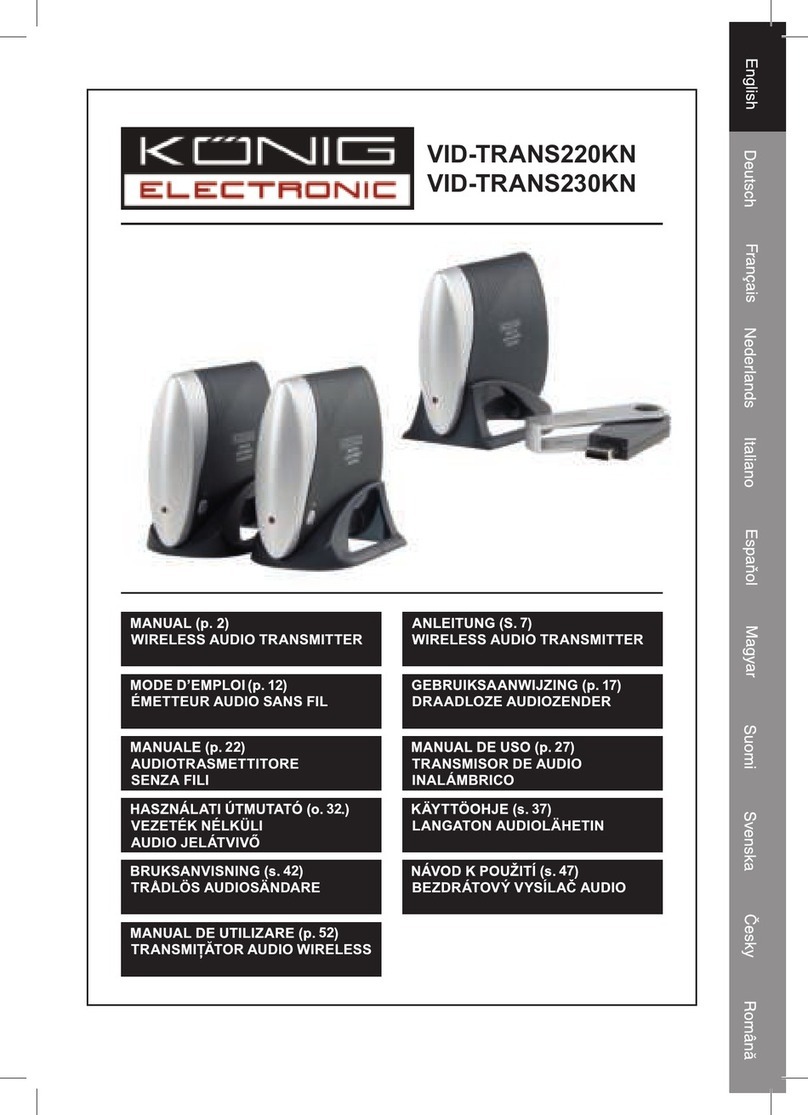
König Electronic
König Electronic VID-TRANS220KN manual
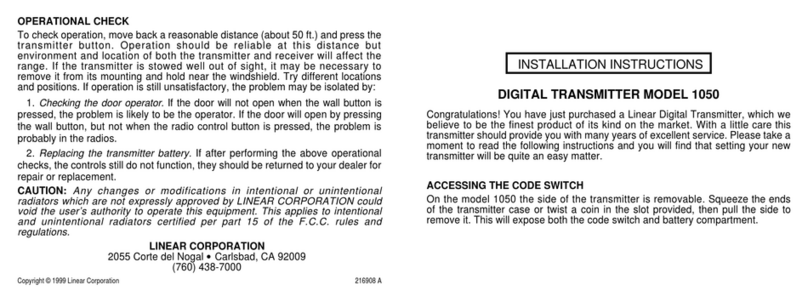
Linear
Linear 1050 installation instructions

AIRTRONICS
AIRTRONICS Vanguard FM 4 Channel instruction manual
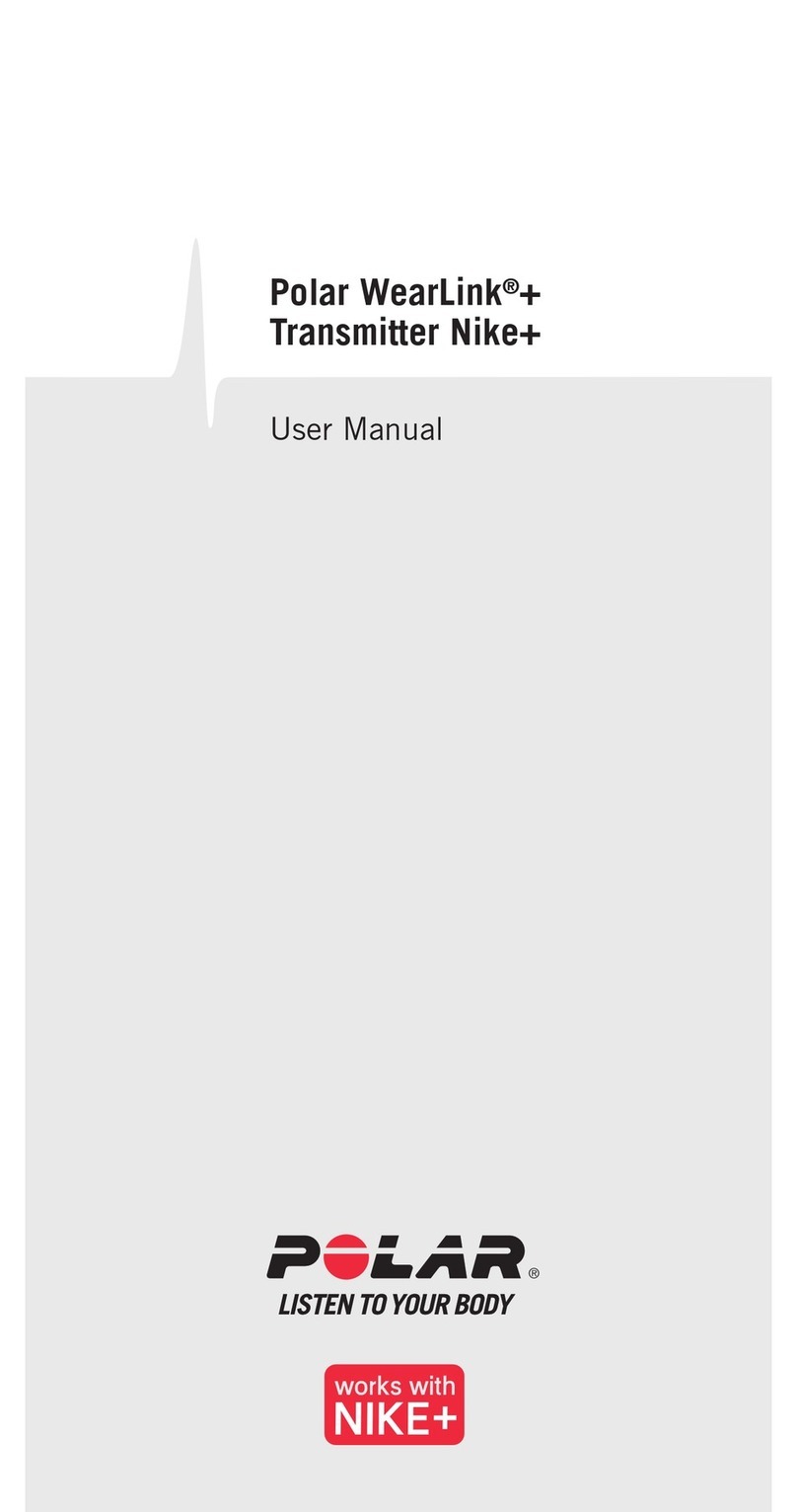
Polar Electro
Polar Electro Transmitter Nike+ user manual

Dakota Alert
Dakota Alert UT-3000 user manual
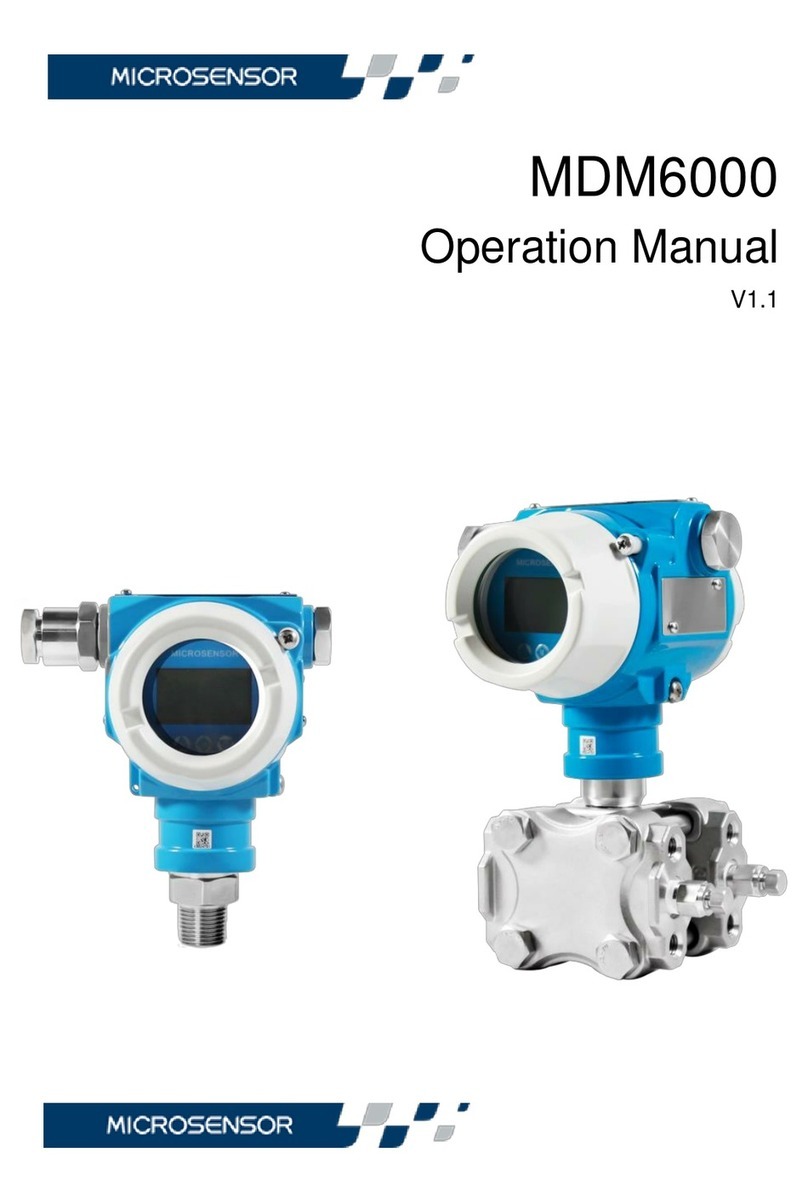
Microsensor
Microsensor MDM6000 Series Operation manual

